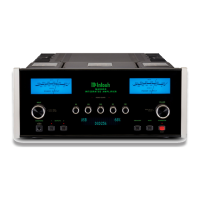
Do you have a question about the McIntosh MA8950 and is the answer not in the manual?
| Power Output per Channel | 200 Watts |
|---|---|
| Number of Channels | 2 |
| Total Harmonic Distortion | 0.005% |
| Input Impedance | 20k ohms |
| Digital USB Input | 1 |
| Digital Coaxial Input | 2 |
| Digital Optical Input | 2 |
| Digital MCT (DIN) Input | 1 |
| Subwoofer Output | Yes |
| High Drive Headphone Amplifier | Yes |
| Tone Controls | Bass and Treble |
| Home Theater PassThru | Yes |
| Frequency Response | 20Hz to 20kHz |
| Damping Factor | >40 |
| Dimensions (W x H x D) | 17.5" x 7.625" x 22" |
| Weight | 75 lbs |
| Speaker Impedance Taps | 2, 4, or 8 Ohms |
| Preamplifier Outputs | 1 |
| Headphone Output | Yes |
| External Control | RS232 |
| Digital-to-Analog Converter (DAC) | Yes |
| USB Input Sample Rate | 32-bit/384kHz |
| Preamplifier Inputs | 6 (1 balanced, 5 unbalanced) |
Product must be installed as per instructions; modification voids authority.
IC compliance, conditions for operation, and radio interference reduction.
Diagrams for front, side, and bottom panel cutouts for custom installation.
Legend and diagram for connecting input and control devices.
Main power input, fuse holder, and fixed/RCA/balanced outputs.
Unbalanced, Phono, Balanced, Optical, and Coax inputs.
Posts for connecting loudspeakers.
Details on XLR, Power Control, Data Port, IR, and RS232 connectors.
Output terminal connector and jumper connector details.
Preparing terminal posts and speaker wire.
Connecting bare wire, banana plugs, and spade lugs.
Input knob, volume, buttons, lights, and meters.
Equalizer toggle and frequency adjustment knobs.
Device selection, input, volume, mute, and power controls.
Setup, trim, equalizer, and playback controls.
Using knobs to navigate, enter, and exit menus.
Settings for inputs, outputs, and headphones.
Configuring triggers, data ports, and passthru mode.
CEC, Lip Sync, USB Automute, and Digital Gain.
Baud rate for RS232 and IR code selection.
Configuring IR sensor, auto-off, and factory reset.
Turning unit on/off, selecting inputs, and adjusting volume.
Trim functions, balance, equalizer, HXD, and muting.
Autoformer, EQ, Bi-Amp, HXD, protection, and passthru.
Using onboard/external amps, USB playback, sample rate display.
Jumper plugs, output types, and knob operation.
Explanation of balanced vs. unbalanced signals.
Power, impedance, distortion, headroom, and damping factor.
Input impedance, S/N ratio, preamp specs, and voltage gain.
Supported digital input formats and sample rates.
Signal levels for digital inputs and equalizer response.
Power requirements, overall dimensions, and weight.
Instructions for repacking and list of materials.